 |  |
By Tom Gatch
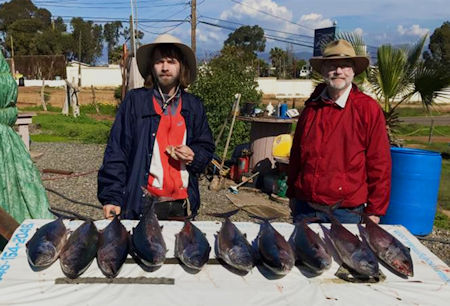
Without a doubt, the winter rainy season in 2017 was intense, but well needed. Rarely do the chaparral covered hills of southern California and Baja Norte look as stunningly emerald as they do right now. Nonetheless, even with occasional breaks in the inclement weather, the fishing plans of many an angler were negatively impacted by the inability to get out on the water. The good news is that California’s snow pack is now seasonally normal again, and we will all benefit from the much needed pure water that it provides.
As the surface ocean temperature begins to rise, the coming of spring presents an excellent opportunity for fishing the surf off of the sandy beaches that pepper the Baja coast.
Halibut and corvina are at the top of the list right now, and can be most effectively targeted on a rising tide by tossing a suspending jerk bait like a Rapala or Lucky Craft out just past the break and then slowly twitching it in. Depending upon your location, you might end up being surprised by the size of some of the fish that you can pull out of the suds when using this technique.
Out beyond northern Baja’s surf zone, Isla Coronado’s north island has been producing a few nice yellowtail, many of which have fallen for a well presented yo-yo iron tipped with a strip of squid. Most of the forktails being caught are home-guard fish that weigh up to 25 pounds.
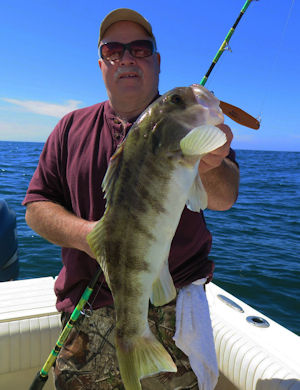
Down the coast a bit, Pacific bonito have been going on a tear in droves, inhaling just about anything that looks like it might make a good meal. A majority of this inshore action has been taking place between La Salina and Punta Santo Tomas. Unfortunately, live bait supplies have been way down, but luckily many of these 5 to 9 pound ‘micro tuna’ are also eating the iron, especially if it has been enhanced with squid.
Many decades ago, bonito was maligned as being undesirable as table fare because of its dark, strong tasting blood line. But when placed on ice immediately after being caught, and then carefully processed as soon as you return to shore, as any sushi chef knows; fresh bonito can be turned in to some of the best sashimi that you may have ever sampled.
Further south in Bahia San Quintin, the bottom fishing has remained solid for reds and lings, with occasional yellowtail showing up when the weather conditions are right.
Former Orange County resident, Denis Quesnel, who was responsible for the creation of the popular, jointed Action Lure decades ago, is now manufacturing a new specialty iron jig, DEADHEAD Lures. And what better place to give them a true field test than in the waters off San Quintin.
Even though the weather was nasty from time to time and the yellowtail didn’t make a showing, Denis still ended up going out with Capt. Juan Cook and catching a cooler full of quality fish on his new jigs, including a few trophy size sand bass.
As is typical this time of year, Baja’s central Pacific coast continues to have a few remaining storms. This has resulted in lower fish counts in both Isla Cedros and Bahia Asuncion, but things begin to pick up the further south you go.
The inshore waters of Bahia Magdalena continue to attract whale watchers, while offshore anglers are reporting increasing numbers of yellowfin tuna in the 10 to 20 pound class. Inside the estero, the fishing has been outstanding for snook, halibut, corvina and even a few nice, medium sized grouper.
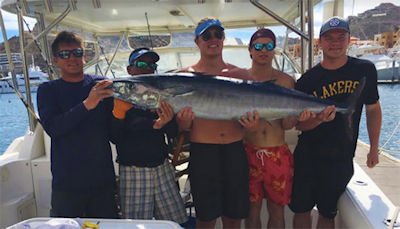
Down in Los Cabos, visiting anglers have been treated to an early run of wahoo. Pieces Sportfishing in Cabo San Lucas reports, “We recently saw our 38 foot Speedwell II, captained by Victor Sandez, land a very nice 45lbs wahoo on caballito live bait for a group of our anglers from St Paul, Minnesota.”
They concluded, “We’ve also been landing some nice yellowtail around 20 to 25 pounds on live bait over on the Pacific side near Migriño. We have also hooked a few grouper weighing about 10 pounds on the same live bait at the same location.
Our top inshore species have been sierra mackerel, red snapper, grouper, amberjack, roosterfish, yellowtail, jack crevalle and ladyfish.”
Just around the corner in San Jose del Cabo, Eric Bricston at Gordo Banks Pangas says, “The big news around here lately has been the great wahoo bite, which is taking place during a time frame that is generally not typical for this elusive gamefish. We have mostly been finding them in schools swimming close to shore off of Punta Gorda.
Another productive bite has been for red snapper, locally called huachinango. They are the true red snapper! We usually catch them over offshore structure and they readily strike a variety of baits, including the red crabs that have been drifting through our waters over the past month or so. They are also hitting yo-yo jigs and have mostly been in the 5 to 12 pound class. These fish are extremely popular with our anglers because they are such good eating.”
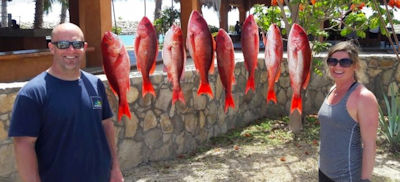
Bricston concluded his report by saying, “Not much going on with any surface action right now, anglers are seeing a few yellowfin tuna showing from time to time, but they have been very finicky, and with the lack of sardinas due to higher surf conditions, it made it difficult to entice any tuna strikes. Very few have been landed recently.
Dorado have been even scarcer, and the billfish bite has been late to get going. We did, however, hear of reports of striped marlin near the 1150 high spot and even a couple of dorado, this area had warmer water temperatures, so maybe something will finally start to happen offshore.
Inshore there has not been much besides some sierra and triggerfish, as water starts to warm back up, we should see the juvenile roosterfish move in. Then later in the spring as the mullet show up, that will attract the larger roosters and other jacks.”
Up the Cortez coast in La Paz, Jonathan Roldan of Tailhunter International returned recently from a promotional tour of several outdoor exhibitions only to discover that winter wasn’t quite over yet.
He reports, “Although the calendar says spring has started, winter isn’t quite ready just yet to give itself up. Last week we had a decent week of fishing as the winds abated and, to some degree, the early part of this week wasn’t bad either.
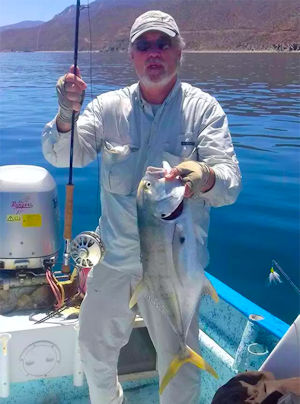
But, then the winds kicked in again, much to the joy of the windsurfers and kite boarders, but it sure didn’t do our fishermen any favors. As the week went on the winds got worse. Over the weekend, there was a huge triathlon in La Paz and the waves and wind in the normally calm Bay of La Paz was tossing swimming competitors back onto the beach.”
Roldan concluded his report by adding, “So, in a quick summary, we have been getting a few tuna now and then, but don’t get me wrong; this is not what you would call a ‘tuna bite’ per se. But, considering that this is so early in the year, it’s surprising to see tuna around of this size and quality. Some of the fish taken near the south side of Cerralvo Island are weighing out at 20 t0 50 pounds. But these are isolated fish, and for the time being it’s a nice bonus, but until I start seeing a lot more of them, I wouldn’t call this a wide open tuna bite.
We have also picked up a few wahoo, but far more common were the types of inshore fish that we usually get during the winter, which include bonito, snapper, pargo, jack crevalle, sierra and even a few amberjack and rooster fish, which is a very good sign for the months to come.”